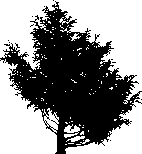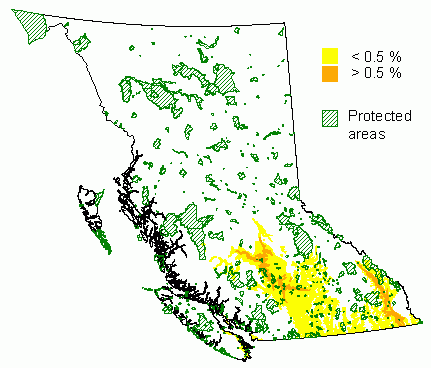 Rocky Mountain juniper
Rocky Mountain juniper
Juniperus scopulorum Sarg.
Introduction
Rocky Mountain juniper is a long-lived species, which can form a shrub or a small tree, rarely larger than 10 m in height. Being shade intolerant, it grows alone or in small clumps, often on exposed sites. Occasionally, it associates with other tree species. It often grows as a pioneer species on isolated sites, and may be present, as a minor component, in early and intermediate stages of secondary succession in open-canopy forests. It is frequent on very dry sites. Bird and animal population sizes and behaviour, as well as site and weather conditions during establishment are largely responsible for the scattered distribution of Rocky Mountain juniper (Burns and Honkala 1990). Its tough wood was used extensively by first peoples for making bows (Turner 1979).
Rocky Mountain juniper is widely distributed in western North America. Within its range the distribution is very scattered (Little 1971). However, the concentrations generally follow the Rocky Mountains with isolated patches further east. It is virtually absent in the Pacific region, except for a disjunct population on Vancouver Island (Burns and Honkala 1990).
Distribution and Protected Areas – from Hamann et.al. 2005



In situ Conservation Status Summary – from Chourmouzis et.al. 2009
“Rocky Mountain juniper is found in many interior zones in southern British Columbia where it is mostly well protected, especially in the IDF zone. In the interior, verification and increased protection in the PP zone are recommended. Coastal populations of junisco, recently proposed as Juniperus maritima [Adams], are considered to be important for genetic conservation but are under-protected in the CDF zone. Pure stands are rare on the coast, and the species is not expected to be present at set threshold levels within protected areas; however, it has a patchy distribution but consistent presence along shorelines, where it could be protected through covenants.”
Inter situ collections
Twenty-six seed sources of Rocky Mountain juniper from the Great Plains area were planted in a provenance test in South Dakota, in comparison with 118 sources of J. virginiana (Schaefer and Baer 1988). Juniper species are widely planted in the Great Plains, especially for soil conservation purposes and windbreaks. Ten-year data confirmed the initial observations that Rocky Mountain juniper grew and matured more slowly. It had a narrower crown than J. virginiana, a smaller branch angle and slightly less apical dominance. Including Rocky Mountain juniper in plantations contributes to species diversity, attractive foliage colour, and lower susceptibility to cedar-apple gall rust (Schaefer 1995).
Reproduction
Rocky Mountain juniper produces large amounts of seed at irregular intervals (Banerjee et al. 2001). A high but variable proportion of the seeds may be empty, and the viability of the filled seed is only fair. The seeds are dispersed by birds and water. Rocky Mountain juniper does not reproduce naturally by sprouts or layering. Interest in propagating and improving juniper is growing in the United States (Lee et al. 1995).
Genetic structure
J. scopulorum hybridizes with J. virginiana in the Missouri River Basin (Van Haverbeke 1968) and with J. horizontalis and J. virginiana in the western portion of the Great Plains (Fassett 1944; Herman 1958; Schurtz 1972). There is introgression from J. scopulorum to J. virginiana (Flake et al. 1978). Population differences can be expected based on the scattered distribution, resulting in limited opportunity for gene flow. Adams (1983) sampled 28 populations of Rocky Mountain juniper throughout its range (six of them in British Columbia) for a chemo-systematic study based on terpenoids. Canonical variate analysis of terpenoid data revealed that Puget Sound-Vancouver Island populations have likely been isolated for a considerable time, maybe before the last glaciation. The populations from the interior of British Columbia may have been recolonized from a refugium in Oregon. In general, Rocky Mountain juniper populations are quite similar in the central portion of the range, but variable at the edges. Adams also collected plants with an intermediate-looking growth habit and confirmed the existence of hybrids of J. scopulorum and J. horizontalis in Banff, but concluded that gene flow was mainly towards J. horizontalis. Rocky Mountain juniper and J. virginiana seem to intergrade across the Great Plains as a series of relict populations (Adams 1983). Studies on volatile oils (Von Rudloff 1975) and isozymes (Kelley and Adams 1977) provide some information about differences among individuals and among populations.
Resource management and seed transfer
Tauer et al. (1987) analyzed the influence of seed source on drought tolerance for a number of sources from the Great Plains, and found that drought tolerance varied significantly among populations in J. virginiana, but not in J. scopulorum. Zhang et al. (1997) evaluated several sources of J. scopulorum and J. virginiana from the Great Plains in a provenance trial in Nebraska. Trees were inoculated with Cercospora blight, a major disease east of the Rocky Mountains. Disease resistance was highly heritable and unrelated to growth capacity. However, the cold and dry climate from the northwestern area of collection combined with the absence of selection pressure for resistance to Cercospora in populations of either species of this area makes them unsuitable for planting in Nebraska (Zhang et al. 1997).
REFERENCES
Hamann, A., Smets, P., Aitken, S. N. and Yanchuk, A. D. 2005. An ecogeographic framework for in situ conservation of forest trees in British Columbia. Can. J. For. Res. 35:2553-2561. View online resources for this report.
C. Chourmouzis, A.D. Yanchuk, A. Hamann, P. Smets, and S.N. Aitken. 2009. Forest Tree Genetic Conservation Status Report 1: In situ conservation status of all indigenous BC species. Centre for Forest Conservation Genetics, Forest Genetics Council of BC, and BC Ministry of Forests and Range, Forest Science Program, Victoria, BC Technical Report 053. www.for.gov.bc.ca/hfd/pubs/Docs/Tr/Tr053.htm
Adams, R. P. 1983. Infraspecific terpenoid variation in Juniperus scopulorum: evidence for Pleistocene refugia and recolonization in western North America. Taxon 32:30-46.
Banerjee, S. M., Creasy, K. and Gertzen, D. D. 2001. Native woody plant seed collection guide for British Columbia. Crown Publications, Victoria. 147 p.
Burns, R. M. and Honkala, B. H. 1990. Silvics of North America vol.1: Conifers. Agriculture handbook 654. U.S. Dept. of Agriculture Forest Service, Washington, D.C. 675 p.
Fassett, N. C. 1944. Juniperus virginiana, J. horizontalis and J. scopulorum. 1. The specific characters. Bulletin Torrey Botanical Club 71:410-418.
Flake, R. H., Urbatsch, L. and Turner, B. L. 1978. Chemical documentation of allopatric introgression in Juniperus. Systematic Botany 3:129-144.
Herman, F. R. 1958. Silvical characteristics of Rocky Mountain juniper. USDA Forest Service, Station Paper 29. 20 p.
Kelley, W. A. and Adams, R. P. 1977. Seasonal variation of isozymes in Juniperus scopulorum: systematic significance. American Journal of Botany 64:1092-1096.
Lee, S. A., Cregg, B. M. and Fleege, C. 1995. p. 47-51 in: Propagation of Juniperus: challenges to propagation and opportunities for improvement. U S Forest Service General Technical Report PNW GTR-365.
Little, E., L., Jr. 1971. Atlas of United States trees, volume 1: Conifers and important hardwoods. U.S. Department of Agriculture. 9 p, 313 maps, Washington, DC.
Schaefer, P. R. and Baer, N. B. 1988. An eastern redcedar and Rocky Mountain juniper provenance test for windbreak suitability in eastern South Dakota. Northern Journal of Applied Forestry 5:129-132.
Schaefer, P. R. 1995. Ten-year results of an eastern redcedar and Rocky Mountain juniper provenance test in eastern South Dakota. Northern Journal of Applied Forestry 12:30-35.
Schurtz, R. H. 1972. A taxonomic analysis of a triparental hybrid swarm in Juniperus L. Dissertation Abstracts International B. 32:6248. [Ph.D.thesis, University of Nebraska, Lincoln. 1971. 98 p.]
Tauer, C. G., Harris, K. D. and Haverbeke, D. F. v. 1987. Seed source influences juniper seedling survival under severe drought stress. Res. Pap. RM-470. Fort Collins, CO: USDA Forest Service, Rocky Mountain Forest and Range Experiment Station. 4p.
Turner, N. J. 1979. Plants in British Columbia Indian technology. B.C. Provincial Museum Handbook no. 38. BC Provincial Museum, Victoria, B.C. 304 p.
Van Haverbeke, D. F. 1968. A population analysis of Juniperus in the Missouri river basin: taxonomic interrelationships between Juniperus scopulorum Sarg. and J. virginiana L. in the Missouri River Basin. Ph.D. thesis. University of Nebraska Studies new series no.38. 82 p.
Von Rudloff, E. 1975. Chemosystematic studies of the volatile oils of Juniperus horizontalis, J. scopulorum and J. virginiana. Photochemistry 14:1319-1329.
Zhang, J. W., Klopfenstein, N. B. and Peterson, G. W. 1997. Genetic variation in disease resistance of Juniperus virginiana and J. scopulorum grown in eastern Nebraska. Silvae Genetica 46:11-16.
